Kongo Prestige Blade (?)
Kongo Prestige Blade (?)
Kongo - Bakuba - Yaka - Chokwe - Lunda (?)
Kingdom of Kongo (Northern Angola - Western Democratic Republic of the Congo) - Portuguese Angola (Angola)
20th century
Iron, ivory (elephant)
Blade: 35,6cm
Hilt & Blade: 48,3cm
Hilt, Blade, Sheath: -cm
Collection Date: 2021
Collection Number: 176
Ex. Rick Stroud (RSWORD): Raleigh, North Carolina, USA (2021)
A curious blade that has not yet been identified. I have gathered numerous opinions from collectors and dealers across America and Europe, and almost every opinion differed in response. The highest frequency opinion landed near the historic Kingdom of Kongo, which is now Northern Angola reaching into Western Congo.
The iron blade is double- edged, symmetrical, with engravings of circle (crescent) and linear motifs. The hilt composed of a massive chunk of elephant ivory, carved with eight alternating faces in two different hair styles with an ellipsoid central grip.
This knife could be a prestige blade, or the hilt and blade could have been unioned together later as the blade is slightly loose but firm in the hilt. The hilt may have been part of a staff or other object. In trying to decipher the face carvings, they were placed by opinions on the Bamileke, Mbuun, Mbala groups, and also the Aruwimi River Region. I have found another similar prestige knife attributed to Aruwimi as well. This example seems to be more Western Congo by the styling. The carved heads resemble faces of those on Kongo ivory statue carvings that gained popularity during the mid-19th century. The detailed features may point toward the Kwango- Kasaï area. Similiar head and facial features, including an arched forehead, cross-hatched hair texture, sided ears, almond- shaped eyes, two section nose, and wide horizontal lips, can also be seen on Kuba palm wine drinking cups with multple faces or janus heads, and Chokwe and Lunda masks and carvings. The faces are not as detailed as some older objects, leading to believe that this piece is not entirely old. This example is yet to be fully deciphered. Please view the attached links below for comparisons on the form and style of similar regional carvings.
Photograph 9: Aruwimi Knife example








